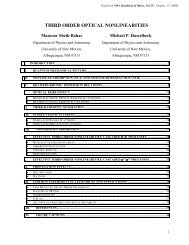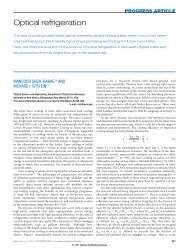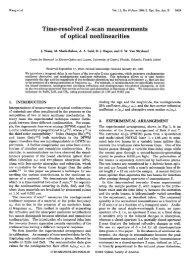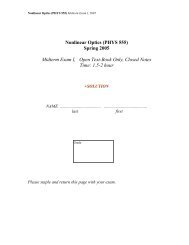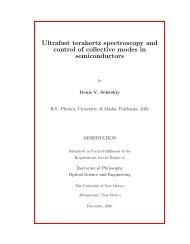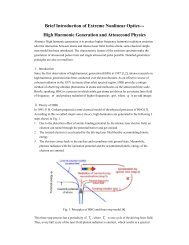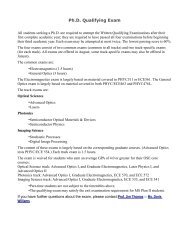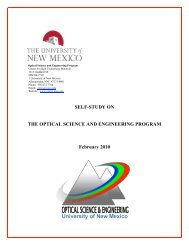Semiconductor Saturable Absorber Mirror (SESAM)
Semiconductor Saturable Absorber Mirror (SESAM)
Semiconductor Saturable Absorber Mirror (SESAM)
You also want an ePaper? Increase the reach of your titles
YUMPU automatically turns print PDFs into web optimized ePapers that Google loves.
Fig. 4. Q-switch vs. CW Mode-locking [3]<br />
This equation is for the picosecond regime modelocked<br />
solid-state lasers. This stable condition is derived<br />
from the coupled rate equations assuming that the<br />
saturable absorber is fully saturated.<br />
Q-switching instabilities occur when the pulse energy<br />
is temporarily increased because of noise fluctuations in<br />
the laser, which then gets even further increased because<br />
of the stronger saturation of the saturable absorber. This<br />
has to be balanced by a stronger saturation of the gain [3].<br />
Stability means that the relaxation oscillation damped.<br />
The physical explanation of Eq. (1) can be, if the pulse<br />
energy rises slightly owing to relaxation oscillations, this<br />
pulse energy fluctuation first grows exponentially because of the stronger bleaching of the absorber.<br />
However, the increased pulse energy starts to saturate the gain. The laser is stable against QML if the<br />
gain saturation is sufficient strong to stop the exponential rise.<br />
Typically the <strong>SESAM</strong> is operated with an incident pulse fluence of about three to five times that of<br />
the saturation fluence. This saturation level of the absorber provides nearly the maximum modulation<br />
depth without damaging the device. Higher saturation also reduces the tendency for Q-switching<br />
instabilities because of thermal effects and two-photon absorption. From [5], it has been confirmed the<br />
presence of two-photon absorption in commonly used <strong>SESAM</strong>s structures by time-resolved differential<br />
reflectivity measurements. With pump-probe measurement confirmation that TPA is the dominant cause<br />
of the reflectivity drop observed in the saturation energy measurement. And they also theoretically<br />
predict that TPA will expand the CWML stability regime<br />
against QML. Fig. 5 illustrates the calculated stability<br />
regions in a logarithmic plot of the saturation power of<br />
the absorber versus the pulse energy, both normalize to<br />
the gain saturation [ ( I<br />
A<br />
AA<br />
/ I<br />
L<br />
AL<br />
) versus ( W / WL<br />
) ],<br />
where AA<br />
is the area of the spot focused on the absorber,<br />
I<br />
L<br />
is the saturation intensity of the gain, A<br />
L<br />
is the area<br />
of the beam in the gain medium and W is the pulse<br />
energy [5]. The solid line in Fig.5 indicates the instability<br />
boundary when TPA is not included; the inclusion of<br />
TPA reduces the instability boundary to the dashed line.<br />
In conclusion, TPA has increased the region for stable<br />
CWML and it can also enable a laser to reach a CWML Fig. 5. Calculated stability contours for a fast<br />
state that was not previously attainable. saturable absorber mode-locked laser. [5]<br />
.<br />
4. <strong>Semiconductor</strong> <strong>Absorber</strong> in Ring Lasers<br />
<strong>SESAM</strong> can also be used in the ring laser configurations. In Fig. 6 a), one cavity mirror is replaced by the<br />
<strong>SESAM</strong> to realize the mode-locking operation of the ring laser [6]. As the cavity length is long, two<br />
lenses (L) are used to obtain tight focus on the <strong>SESAM</strong>, so that high saturation of the absorber can be<br />
obtained. This configuration will result in bi-directional operation of a pulsed ring laser, which is the<br />
basic model for the laser gyroscope.<br />
To increase the flexibility of the setup, another cavity configuration is designed, as shown in Fig.6 b),<br />
4


